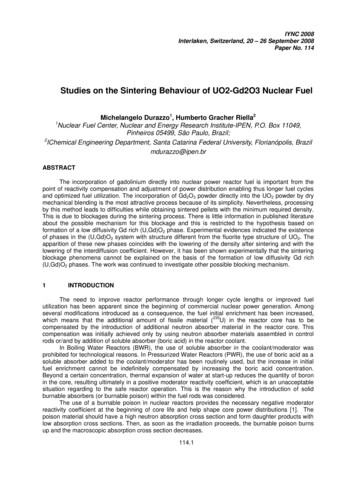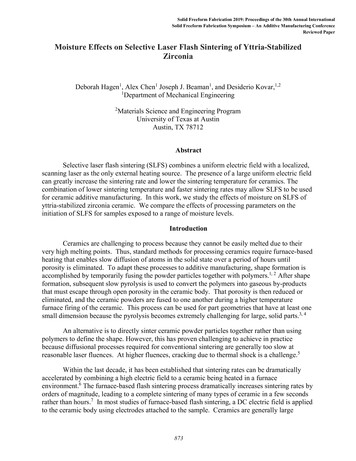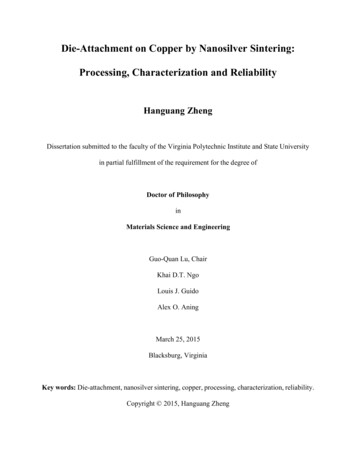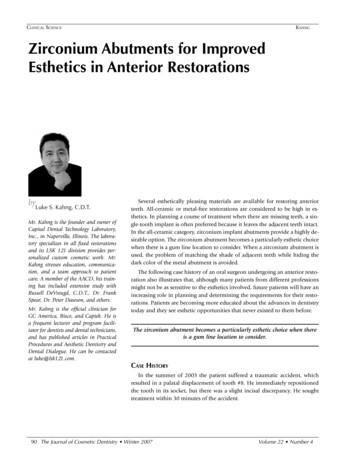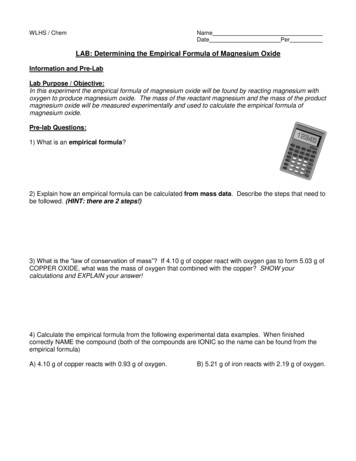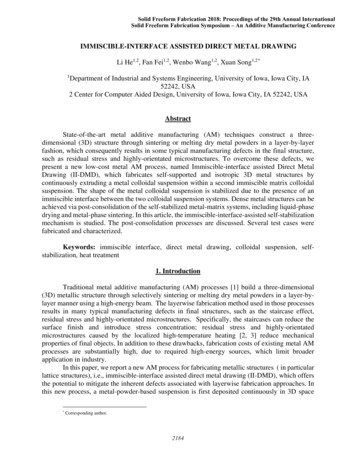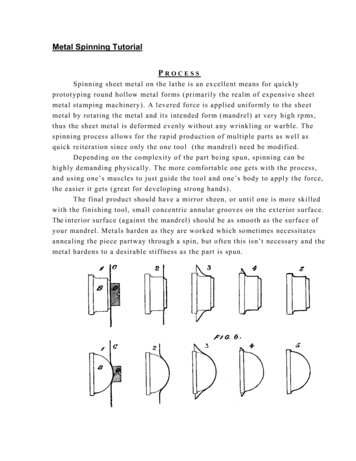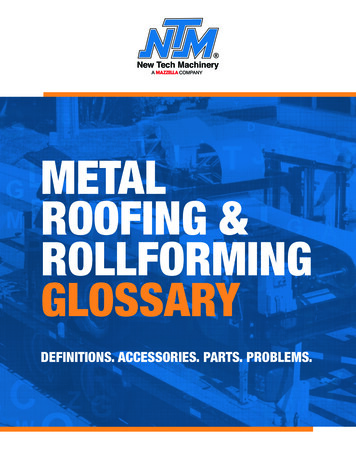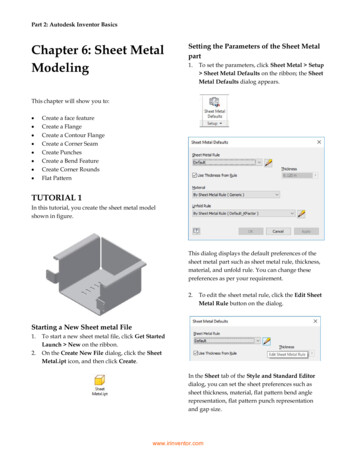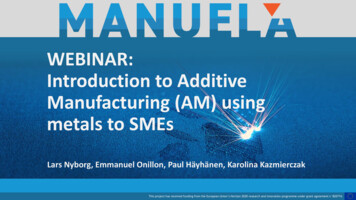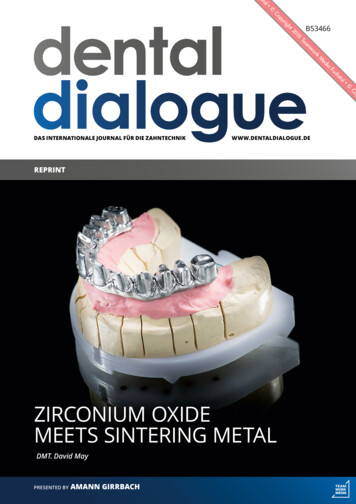
Transcription
B53466DAS INTERNATIONALE JOURNAL FÜR DIE ZAHNTECHNIK WWW.DENTALDIALOGUE.DEREPRINTZIRCONIUM OXIDEMEETS SINTERING METALDMT. David MayPRESENTED BYAMANN GIRRBACH
TECHNOLOGYModern solution approach for a fixed implant prosthetic reconstructionZIRCONIUM OXIDEMEETS SINTERING METALAn article by DMT. David May, Lindau/GermanyCONTACT DMT. David MayHOMEPAGEPhone 49 8382 93750Lindauer Zahntechnik GmbHFax 49 8382 937523Schachener Straße 163www.lindauer-zahntechnik.de88131 Lindauinfo@lindauer-zahntechnik.de02 – dental dialogue VOLUME 19 – 6/18
TECHNOLOGYMany patients express a desire for fixed implant prosthetic solutions that calls on thecreativity of the dental technician. Creativity both in terms of the type of restoration aswell as in terms of the costs, which must not be exorbitant. After all, implant prostheticsshould not be reserved for the upper ten thousand. In this article, David May presentsa concept for generating CAD/CAM-guided implant-supported dentures that are bothesthetic and cost-effective.KEYWORDSDD-CODE CAD/CAM technology Sintering metal Fixed dentures Full ceramic crownscode into the search box on Milling Zirconium oxidewww.dentaldialogue.de and Implant prosthetics j9tevSimply enter this ddcall up additional contents.6/18 – dental dialogue VOLUME 19 – 03
TECHNOLOGY01 - 03Initial planning situation for solving the patient case: The scanned long-term temporary restoration formed the basisfor the final restoration. After all, this treatment has proven itself in the patient’s mouth for three months04The temporary restoration for the veneer was reduced inthe Amann Girrbach Ceramill Mind softwareProlog05Due to the strong angulation of the implant in region26, an angled titanium base had to be planned heretreating dentist. The individual digital andtibase abutments from Medentika, whichanalog work steps are documented in theare offered by Amann Girrbach.In the age of implantology, more and morefollowing case study.The conical titanium bases and bondingpatients are presenting themselves in dentalThe patient first came to us when she hadbases enable the fabrication of multi-pon-practices with a desire for treatment withalready received six implants in Regio 11,tic screw-retained bridge constructions onfixed dentures. They long for a better quality13, 16, 21, 23 and 26. During the healingimplants. In addition, they allow compensat-of life and wish for a carefree smile.phase, she wore her telescopic prosthesis,ing small divergences. Medentika's Medent-At the time our patient consulted the prac-which had been reworked to a full denture.ibase abutments are available in five gingivatice, she had been provided with a telescopicprosthesis in the maxilla, which had beenconverted into a full denture. Her ultimateScrew-retained temporaryrestoration on implantswish was to be provided with fixed, function-heights to ensure optimal adaptation to thevertical implant position and the emergenceprofile. After a thorough functional analysis,we began with the fabrication of the long-al dentures. Dentures that were to meet herIn the following step, the patient was pre-term temporary restoration.high esthetic demands.pared for the final work with a screw-re-An esthetic tooth set-up was created on anSuch functional prosthetic rehabilitationtained temporary denture. An occlusallyindividual acrylic base. This already camerequires well thought-out therapy plan-screw-retained bridge was to be fabricat-very close to the patients expectations. Asning. The patient's wishes were summa-ed for the final restoration. For the occlusalbonding bases had been incorporated intorized and implemented together with thescrew connection we decided to use Meden-the acrylic body, the esthetic set-up could04 – dental dialogue VOLUME 19 – 6/18
TECHNOLOGY06 & 07Of course, the material parameters of the Ceramill Sintron sintering metal were taken into account when planningthe framework. The milled CoCr frame fitted precisely and distortion-free after sinteringbe screw-retained firmly in the mouth and,Based on the ideal situation already workedhave become more efficient and one expe-in a further step, the function and estheticsout, a new scan was therefore performedriences a significant increase in the safetycould be checked conclusively.(Figs. 1 to 3). After completing the scanningof the work process.Before the CAD/CAM-supported manufac-process, the frame was virtually adapted.After sintering the milled structure, a bio-turing process could begin, the patient'scompatible, stable, homogeneous and dis-minimal requests for changes were accept-The design of the bridge framework wastortion-free CoCr frame is the result (Figs. 6ed. The CAD/CAM-supported planning andstarted in the software. As this was to beand 7). The casting and labour-intensivefabrication process could now begin withmanufactured from the millable Ceramillfinishing of CoCr is therefore no longerthe finished tooth set-up which then actedSintron sintering metal, the correspondingnecessary.as our blueprint for the final restoration.material parameters had to be observed. AsAfter checking the fit, we polished the basea first step we designed a reduced wax-upto a high gloss and bonded the bonding bas-First, the esthetic set-up was scanned and(Fig. 4). We reduced the tooth sections soes to the frame. Now the Sintron structurefully anatomically milled from acrylic. For thisthat the shape resembled a prepared stump.could be screwed onto the model (Figs. 8purpose we use the Ceramill Temp MultilayerThe gingival portion was also defined.and 9).acrylic blank from Amann Girrbach, whichThis situation now formed the basis for theis approved for long-term temporary resto-We had adopted the model, gingiva andesthetic finalization of the superstructure.rations. As the shade layers of the blanks areabutment situation for the scan. We there-For this purpose, the model including the Sin-modeled on the structure of natural teeth,fore screwed the matching scanbodies ontotron bridge was duplicated and another sawonly minor corrections had to be made.the model analogs. Due to the strong an-model produced. This allows the preparationThe gingival region was overlaid with gingi-gulation of the implant at 26, a 20 angledmargin for the individual crowns to be betterva-colored, light-curing composite. Finally,Camlog titanium base had to be used. Thisdisplayed and checked. This saw model wasthe adhesive caps were worked in so thatmade it possible to optimize the emergencescanned and the data obtained "matched"the temporary denture could be screwed toof the occlusal screw connection in the oc-with the CAD data of the temporary bridge.the titanium bases in the mouth.clusal surface (Fig. 5).This enabled us to revert back again to theWith this screw-retained, temporary bridge,our patient enjoyed her new outlook on lifefor about three months. The extension of thePerfect symbiosisof stability and estheticsfull anatomy of the future crowns.For esthetic reasons, we reduced the front labially to allow us to veneer it individually withceramics (Fig. 10). For the posterior crowns,base, as well as the shape and color shade ofthe teeth almost corresponded to the finalFor reasons of stability, Ceramill Sintron waswe chose the fully anatomical shape, whichrestoration.used as material for the bridge framework.had already proven itself for the temporaryAfter the positive feedback from the patient,This is a so-called sintering metal, which in itsrestoration.we could proceed to start on the definitiveraw state has a wax-like consistency and canFor the monolithic crowns, we used thework. The model for this was the fully ana-therefore be easily processed with desktopsuper highly translucent Ceramill Zolid FXtomical situation of the temporary bridge.milling machines. As a result,the workflowsMultilayer zirconium oxide from Amann Gir-6/18 – dental dialogue VOLUME 19 – 05
TECHNOLOGY08 & 09After checking the fit, the base of the frame was polished to a high gloss. The bonding bases could then be bondedto the frame so that the frame could be screwed onto the model analogs10For the construction of the single crowns, which were later to be bonded to the frame, the frame was duplicated togetherwith the model and a saw model was fabricated and scanned in. The data of the provisional bridge provided the full anatomy ofthe teethrbach. This material enables the fabricationreduced anterior crowns with minimal indi-The try-in showed that our work approach,of tooth structures and frames with an inte-vidual layering. To this purpose we used thewhich always followed the blueprint of thegrated shade gradient. Soft color transitionszirconium oxide veneer ceramic Noritaketemporary restoration, had proved to be ef-inspired by nature simulate enamel, den-Cerabien ZR. The CoCr frame was silanizedfective. The implant-supported bridge couldtine and cervical shades, without disturbingin the classic manner and opaqued (Fig. 12).thus be completed.breaks in color.To condition the Zolid FX Multilayer crowns,Such tooth-like pre-staining allows for ef-As a precaution, another try-in was made.we used Monobond Plus from Ivoclar Viva-ficient and economical processing withoutFor this purpose, the crowns were provision-dent. The ceramic crowns were finally bond-requiring a further manual coloring process.ally bonded to the frame and the gingivaled to the frame using Multilink Hybrid Abut-After the sintering process, the individualsection was modeled from pink wax. Thement – also from Ivoclar Vivadent.crowns were adapted (Fig. 11). The Zolid FXtry-in proved very exciting for the patient,Using different gingiva materials from theMultilayer crowns could be individualizedthe clinician as well as for us. This is whereCeramage composite system by Shofu, wevery well with stains, so that an esthetic re-it is revealed whether the work was precisecreated a natural-looking gingiva (Figs. 13sult could be achieved without great layeringand the transfer from analog to digital hasto 17).efforts. We added some life to the labiallyworked.06 – dental dialogue VOLUME 19 – 6/18
TECHNOLOGY11The anterior teeth were labially reduced and the pos-terior teeth were fully anatomically designed and milled.12 were milled from the super highly translucent zirconiumoxide Zolid FX Multilayer. The opaqued frame in the background.The crowns 13 - 15The finished ceramic crowns were bonded to the conditioned Ceramill Sintron frame using Multilink Hybrid Abutment.We completed the labial surfaces of the anterior crowns with minimal layering and the Noritake CZR veneer ceramic. We layeredthe gingiva region with the gingiva materials of the Ceramage composite system from Shofu Dental6/18 – dental dialogue VOLUME 19 – 07
TECHNOLOGY16 & 17The finished, fixed implant-supported bridge in situ. With the help of the described procedure, the patient was offeredan inexpensive restoration that meets the requirements for esthetics and stabilityPRODUCT LISTProductNameCompanyBonding materialMultilink Hybrid AbutmentIvoclar VivadentCAD/CAM systemCeramill CAD/CAM SystemAmann GirrbachCoCr alloyCeramill SintronAmann Girrbach Regio 11, 13, 16, 21, 23 MedentibaseMedentika Regio 26 Titanium base, 20 CamlogImplant systemCamlogCamlogComposite, gingival veneerCeramage Gum color Full SetShofuAcrylic, temporary restorationCeramill Temp MultilayerAmann GirrbachUniversal PrimerMonobond PlusIvoclar VivadentVeneer ceramic, zirconium oxideNoritake CZRGoldquadratZirconium oxide, crownsCeramill Zolid FX MultilayerAmann GirrbachConclusionpromises in terms of esthetics. In the end,the screw channels closed. The patient waswe all looked forward to the day when thehappy and left the practice with a completelySuch restorations inspire our patients be-finished work could be handed over to thenew attitude to life. cause they receive fixed dentures despitepatient. After incorporating the implanttooth loss and do not have to accept com-restoration, the screws were tightened andImplant assembly componentsPROFESSIONAL CAREERDMT David May completed his dental technician training in Stuttgart in 2000. From 2000 to 2003 he wasemployed by the Weber laboratory in Ravensburg. He then worked in the Stroppe-Jäger dental laboratoryin Lindau, where he gained experience in all areas of dental technology. In 2010 he successfully passedhis Master's examination in Karlsruhe and Halle – by taking external courses. Since 2017 he has beenworking with Rosa Winterhalter as a business partner at the Lindauer Zahntechnik GmbH in Lindau.08 – dental dialogue VOLUME 19 – 6/18
02 - dental dialogue VOLUME 19 - 6/18 TECHNOLOGY Modern solution approach for a fixed implant prosthetic reconstruction An article by DMT. David May, Lindau/Germany ZIRCONIUM OXIDE MEETS SINTERING METAL CONTACT DMT. David May Lindauer Zahntechnik GmbH Schachener Straße 163 88131 Lindau Phone 49 8382 93750 Fax 49 8382 937523 www.lindauer-zahntechnik.de info@lindauer-zahntechnik.de .
